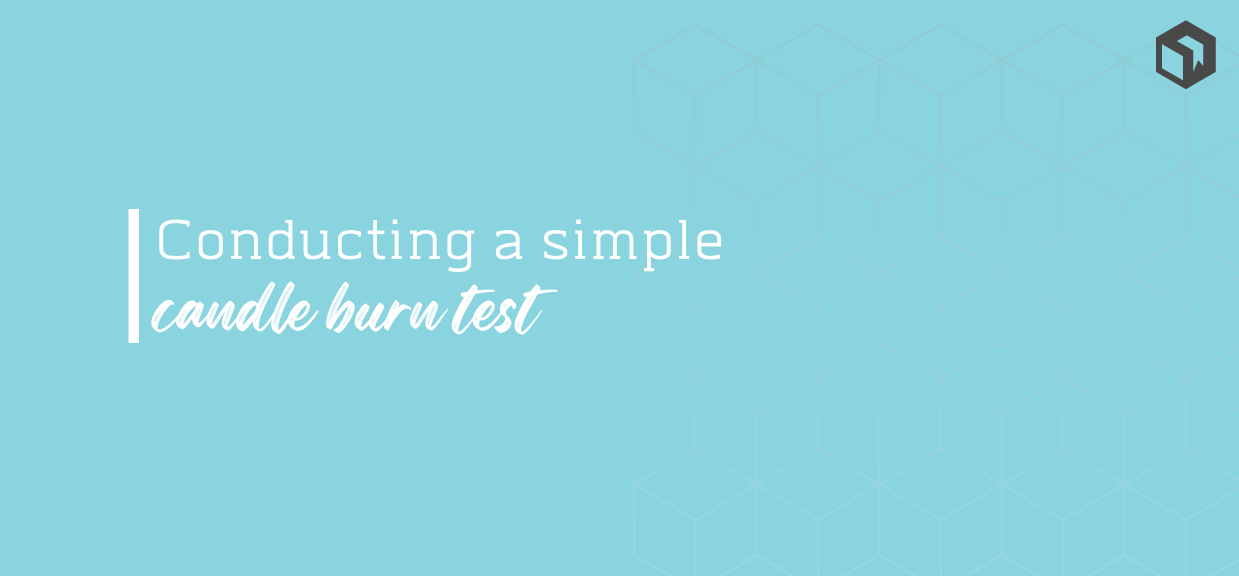How to conduct a simple candle burn test
We show you how to conduct a simple burn test for your candles.

When making candles, it is really important to conduct candle burn tests to ensure that the candle meets safety and performance standards.
Regardless of whether you will be selling your candles, a burn test will provide you with an idea of how well designed your candles are, helping you optimize their performance while maintaining safety standards.
If you are looking to conduct a simple candle burn test, read on to find out how.
What is a candle burn test?

A candle burn test is really just a method of testing to see how well a candle burns. This is done by burning the candle under controlled conditions and observing the flame, wick, and melted wax.
A candle burn test can last as long as a few weeks, depending on your candle, as each candle in the test will need to be burnt in until the candle is either used up or fails. As candles are combustible, it is important that your candle can fill a room with aroma, without sacrificing safety.
The purpose of a candle burn test is to check if your candle making process meets certain safety and performance standards, such as:
-
The candle should not drip or smoke excessively
-
The candle should have a well-defined flame
-
The candle should not burn for more than 4 hours
Why you should conduct burn tests on your candles
Candlemakers typically use this test to prove to customers and themselves that their candles are safe, with an appropriate hot throw.
As mentioned, this candle burn test can help ensure that your candle meets the necessary safety and performance standards.
Another purpose of this candle burn test is to tell if your candle needs a larger, smaller, or different wick. As fragrances and waxes have different thicknesses and viscosity, you will need to use a proper wick for your candle to perform safely. for example, thicker fragrance oils and high viscosity waxes will need a thicker wick, as compared to thinner fragrances and waxes.
Read more:
How to conduct candle burn testing

Before you begin…
The most important part before conducting a test burn is to ensure that your candles are made and substantially cured.
Waiting for your candle to cure for the recommended amount of time is a necessary step before starting your burn testing.
As wax changes dramatically as it hardens, starting your candle burn test before it is properly cured can result in a misleading test result. Remember that patience is needed, especially when waiting for your candle to cure.
If you intend to test multiple candles at once, ensure that they are clearly labeled with batch numbers if possible.
To conduct a basic burn test, you will need the following materials:
-
A candle
-
A lighter or matches
-
A stopwatch or timer
-
A pen and paper
Set up your candle on a stable surface, away from any flammable materials. Light the candle with a lighter or matches, and start the timer.
Observe the candle flame, wick, and melted wax for the next 4 hours. Make note of any irregularities, such as if the candle starts to drip or smoke excessively.
Once 4 hours have passed, extinguish the candle flame and observe the candle wax. The candle is considered to have passed the burn test if:
-
The candle has burned evenly across the entire width of the wick
-
There is less than 1 cm of wax remaining in the candle
If the candle has not burned evenly or there is more than 1 cm of wax remaining, the candle has failed the burn test.
Once you have the basic idea of a candle burn test mastered, you can move on to implementing the more standardized ASTM one.
ASTM standard burn test
The American Society for Testing and Materials (ASTM) is an international standards organization that develops and publishes voluntary consensus technical standards for a wide range of materials, products, systems, and services.
Read more: Don’t get burned! Know the legal requirements for selling homemade candles
While the candle-making burn test we described earlier is a good way to get started, the ASTM candle burn test is a more standardized version that candle makers often use. This is to ensure that their candles meet certain safety and performance standards set by the ASTM.
The ASTM candle burn test involves the following materials:
-
A candle
-
A lighter or matches
-
A stopwatch or timer
-
An exhaust fan (optional)
-
A pen and paper
-
Trim the wick to 1/4 inch.
-
Place your candles on a flat heat resistant surface. If you are testing multiple candles, keep each candle 3-6 inches apart.
-
This area should be clearly visible as your candles should not be left unattended while lit, especially so when testing new wicks.
-
Light your candles and take note of the time.
-
After 2 hours, observe the candles and take note of any noticeable details, such as the melt pool and wick appearance.
-
After 4 hours, observe the candles once again, taking note of noticeable details, before blowing out the flame.
-
Allow your candles to cool for at least 5 hours and repeat until the entire candle is completely burned.
Customising your candle burn test
While the ASTM candle burn test is a great way to candle makers to test their products, you may want to modify it slightly to better suit your needs.
For example, if you are testing a new candle fragrance, you may want to increase the burn time to 8 hours to better understan how the fragrance will develop over time.
You may also want to test different wicks to see which one burns the candle more evenly.
As an example of a customized process, check out Black Tie Barn’s video on their candle testing strategy.
Burn test results

By observing your test results, you will be able to identify if your candle needs a bigger or smaller wick.
If the wick is too big or too hot, you will notice:
-
Your container temperature exceeding 140F
-
5mm or greater carbon balls
-
Excessive soot
-
Flame greater than 3”
-
Large melt pool
While if the wick is too small, you will notice:
-
Candle tunneling
-
Flame that extinguishes before the end of the candle
-
Wax on the edges after your candle finishes
Using batch manufacturing software to track your burn tests
Batch manufacturing software like Craftybase can help with the task of your burn tests by allowing you to track not only your candle recipes but also your batches and full manufacturing process. This way, you’ll have the records you need on hand to ensure that your tests are compliant.
To learn more about how Craftybase can help you track your candle manufacturing process, sign up for a free trial today.
Conclusion
A candle burn test is a great way to check if your candles are safe and fit for purpose. By following the steps outlined above, you can easily conduct a candle burn test at home.
